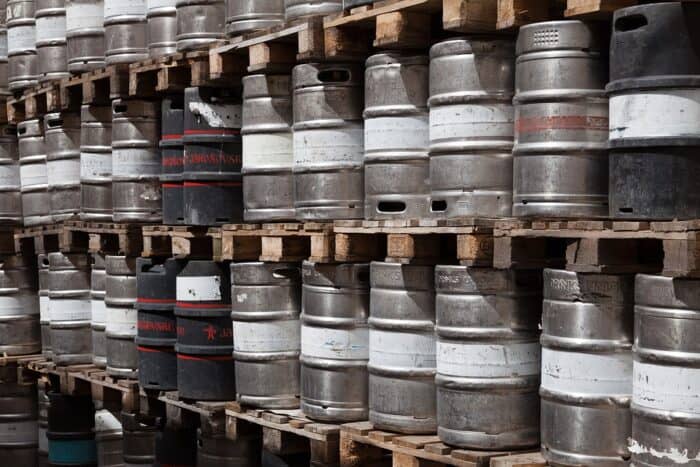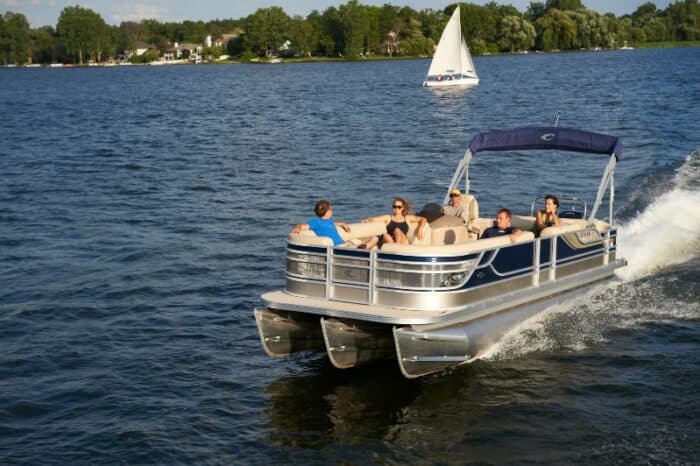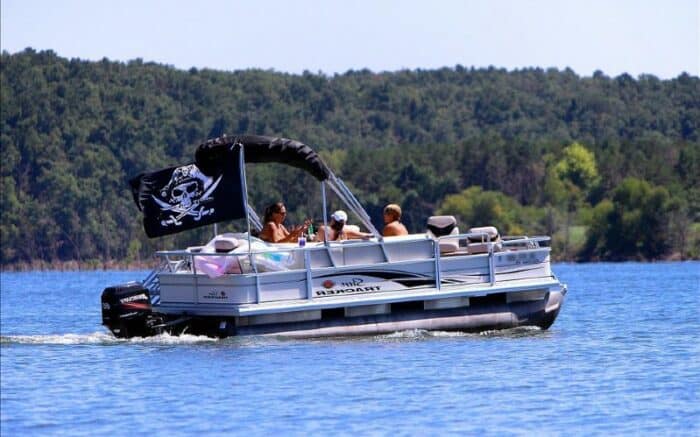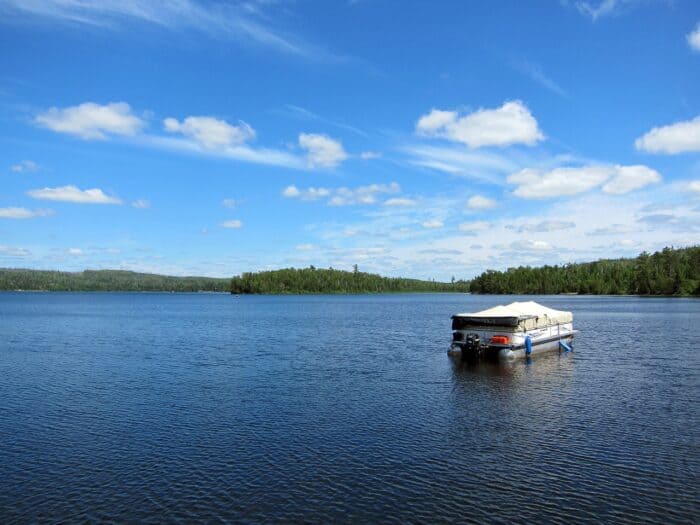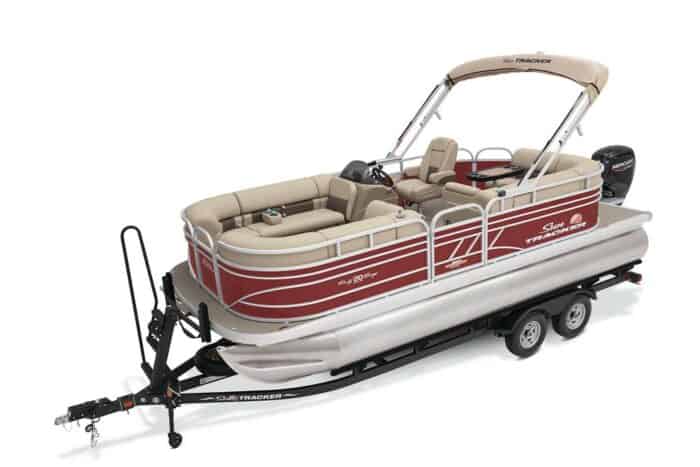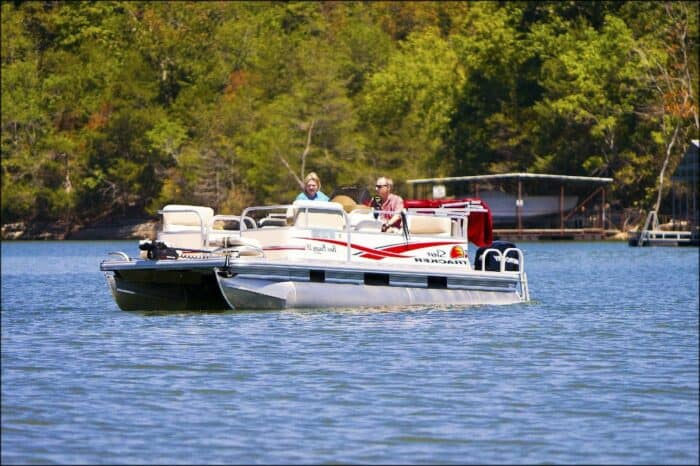What is a Pontoon Boat?
Pontoon boats are flat decked, recreational boats that rely on air-filled tubes called pontoons to achieve buoyancy in the water. Traditional pontoons use a pair of pontoon tubes located on either side of the boat under the deck to achieve stability and buoyancy. Some models may have a third tube located under the center of the boat which increases buoyancy and stability. These boats with three pontoons are often called tritoon boats. There are also inflatable pontoon boats which have softer air filled chambers.
Older Pontoon Boats
Pontoon boats had fallen out of fashion for some years and are only now enjoying something of a resurgence in popularity these last couple of decades. Prior to this, pontoon boats were considered very much underpowered and best suited for leisure activities like slow cruising and fishing.
The earliest motorized pontoons in America date back to the 1950s in Minnesota. A farmer named Weeres came up with the idea to weld some old steel drums together in columns and then strap a flat deck to the top of them. When sealed air tight, the drums provided exceptional buoyancy and the flat deck on top of them didn’t need to be bound by the traditional limitations of size and shape that other boat decks adhered to do the shape of the boat’s hull.
Weeres fixed an outboard motor to the rear of the deck and at the bow he had a stick used for steering. The stick connected by two lines to the engine such that if he pushed the stick left, the lines connected to the outboard would pull it to one side and make the boat go left. To go right, he’d push right.
The big advantage to the pontoon was that it was a lot more stable than traditional boats. Weeres lived in Minnesota where lake fishing was huge. But the lakes are small and people used small fishing boats that had a habit of being pretty unstable on the water. The pontoon boat eliminated that problem by creating a boat many still feel is virtually unsinkable due to the air chambers under the deck. Also,since the pontoons elevate the deck, taking on water is almost impossible to do in calm waters.
These early boats were literally just platforms on pontoons and nothing more. This idea was evolved to replace old steel drums with custom made aluminum tubes that would also be airtight and run the length of the boat from bow to stern. Seats were added to increase comfort and appeal and something closer to our modern idea of a pontoon began to take shape.
The major downside of pontoons for years was that they were slow. The motors used on older pontoon boats were cheap and simple, often with very limited horsepower. Since these were just leisure and fishing boats, performance was never a concern. And the very idea of using a pontoon for watersports was not a consideration at all.
Uses For Modern Pontoon Boats
Modern pontoon boats can fulfill a number of functions that expand upon those original design intentions.
- Fishing: Pontoon boats were designed for fishing and still excel at this task. The stability on the water and the shallow draft means they can handle going into the shallowest of waters in pursuit of fish, including places where virtually no other boats can reach. They also have added deck space for fishing gear and multiple anglers. Modern fishing pontoons may also include live wells and other accessories to make a fishing trip easier.
- Leisure cruising: This is another place where pontoon boats excel for family and individual use. On inland waters when the day is calm you will likely never enjoy as calm and smooth a ride as you’ll get in a pontoon boat. Many pontoon boats come with lower horsepower motors so that the boat is not designed for or capable of any really adrenaline-pumping speeds.
- Water sports and snorkeling: What I just said aside, some pontoons and especially tritoons can be equipped with much more powerful engines. A pair of 350-hp engines on a tritoon boat can ensure that you can achieve speeds ideal for tubing and water skiing. Larger pontoons in the 25 foot and above range can also include slides, ladders and other amenities that make water sports and snorkeling much more reasonable and appealing options.
- Party boats: There is actually a model of pontoon boat sold under the name “Party Barge” which should give you an indication of how these boats can comfortably accommodate gatherings on the water. A 27 foot party boat could easily accommodate as many as 15 people without overtaxing the weight limits of the vessel. For that reason, pontoon boats are often rent out as part boats and some people run businesses on lakes where people can gather on larger pontoons for parties complete with bars and music.One point of caution here is that a pontoon boat can accommodate a larger number of people than similarly sized boats but there are limits. Every pontoon boat has a weight capacity that needs to be adhered to. The problem is that the boat will have enough space to accommodate more people than its capacity will allow for. That can and has led to pontoon boats sinking because they were so overloaded the pontoons could no longer maintain buoyancy. If a pontoon boat is meant to accommodate 15 people, even if 20 people can fit on the deck, it’s a bad idea to overload the vessel.
- Tours: Pontoon boats are often used as tour boats on rivers and lakes to point out the local scenery for tourists and visitors again because of that stability and the overall smooth ride. So long as the water remains calm, many boaters find pontoon boats to offer the gentlest ride you’re likely to get on the water. Even people who have a history of getting sea sick tend to agree that a pontoon boat is a lot easier on their stomachs and if they do end up feeling queasy, it’s usually nowhere near as bad as it would be on a traditional boat.
- Ferries: A number of larger ferries may be tritoon boats because of their ability to handle large weight capacities while still maintaining a smooth and stable ride overall. These commercial pontoons are often much larger than traditional recreational pontoons but the basic principles and operation of them is basically the same.
Characteristics of Modern Pontoon Boats
Regardless of what the pontoon boat is for there are a handful of things that you can expect from a pontoon boat that really cut to the core of what they are and what they do.
- Pontoons: This is a bit of a no-brainer but a boat absolutely can’t be a pontoon boat without the pontoons that make it such. This is the single most integral aspect to the proper definition of what a pontoon boat is. If it doesn’t have tubes under the deck to provide the boat’s buoyancy then it can’t be a pontoon boat.Anything that is sealed and capable of providing buoyancy can be used as a pontoon. That was the case with the original design when the pontoons were literally just sealed barrels. Later pontoons were long aluminum tubes but these proved to be less than efficient if they were damaged. If the tube became cracked or broken it would fill with water and that side of the boat would sink. Because the pontoons balance the boat, a damaged pontoon would capsize the boat on one side and there was a risk of flipping the vessel as well.Modern pontoons use chambered tubes. Although the pontoon tube looks like a single tube from the outside, inside it will be divided into a number of sealed compartments. That way, if the tub suffers structural damage bad enough to cause a break, only a single chamber will flood. The pontoon will lose some buoyancy but should retain enough, combined with the other tube or tubes, to safely get the boat back to shore for repairs.
- Flat Deck: The other main feature of a pontoon boat that is still with us from the same early design Mr. Weeres made is the flat deck. The original pontoon boat was literally nothing but a flat deck. Modern pontoons will include seats, maybe a bimini top, railings and various amenities but the deck space continues to be one of the biggest selling points of a pontoon. This is what allows them to be so useful as both fishing boats and family or party boats. The increased deck space over that of a different kind of boat of similar length allows more people and gear to be on board.
- Stability: Dual pontoons and to a greater degree triple pontoons provide unparalleled stability to a pontoon boat. On calm waters it is nearly impossible to flip or capsize a pontoon boat unless the pontoons themselves become compromised.In a traditional fishing boat, even a flat bottomed boat with a shallow draft, if you were to rock back and forth you would immediately feel the boat’s instability. If a couple of people are in the boat and they all lean to one side quickly, the boat may tip and take on water. This could even capsize the boat. That’s because the structure of the boat itself is in the water. It’s true of sailboats, jon boats, bass boats and even kayaks and canoes.In a pontoon boat you are on the water more than you are in it. The pontoons do have a shallow draft but it’s very negligible if the boat is not overloaded and the rest of the vessel does not contact the water at all. It therefore takes a lot more effort, including weight, to tip a pontoon boat to the point that it will likely only happen if the boat is very much overloaded or the weather has turned and you’re on rough water.
- Control: It’s very easy to drive a pontoon boat although it is different from controlling a regular boat. Turns tend to be wider and take longer to execute.
- Motors: Contrary to popular belief, not all pontoons use outboard motors. The vast majority of pontoon boats make use of outboard engines but some pontoon boat manufacturers in more current models make use of inboard motors or sterndrive engines. Bennington, known for making some of the high end luxury pontoon boats, has a number of models that make use of an inboard motor as opposed to an outboard engine. These allow for watersports more easily than an outboard, and may be better suited for the larger and heavier pontoons that are being marketed today.
Potential Risks of a Pontoon Boat
A pontoon boat may offer stability that other boats cannot but it does come at a price. The benefits of a pontoon boat tend to be quickly undone on rough waters. This is one of the reasons you will almost exclusively find pontoons in inland waters like ponds, rivers and lakes. These tend to be calmer waters overall while the open seas can offer a lot of choppy water at the best of times.
The problem with a pontoon boat on rough waters is the design. If the water is calm then the boat rests on top and provides a great platform for fishing and cruising. But when the water starts to get rough, a pontoon is unable to weather that as easily as a traditional boat with a v-shaped hull, for instance. The waves control the pontoons and will lift and drop the boat as they rise and fall.
Heading into waves is also a danger as a traditional boat’s hull is shaped and designed to cut into waves which is why boats come to that v-shaped point at the bow, traditionally. This allows for smoother passage through water. But because a pontoon has a squared off bow, the waves will crash onto and over it. If waves reach a height of two feet or greater, expect to have a lot of water washing over your deck. For that reason, if you’re in a pontoon you should get back to shore as quickly and safely as you can in bad weather.
It’s much harder to control a pontoon boat in rough waters than on still waters. Steering and maneuvering will take a lot more work. This needs to be done carefully because, although the risk of sinking a pontoon boat is very small, it is more likely to happen in these conditions than any others.
The problem comes from a pontoon’s tendency to dip at the bow. If you are heading into choppy waters and the engine is not trimmed correctly, you may find that the bow is diving down into the waves that are crashing against it. If this happens with a powerful enough wave, it could wash across the bow and force it even deeper into the water, potentially flipping or capsizing the pontoon.
The Bottom Line
In the simplest terms a pontoon boat is a vessel with a flat deck that rests upon a pair or trio of air-filled tubes called pontoons that provide buoyancy. Now that pontoons are enjoying a renaissance with boaters, manufacturers are making them a lot more complex than just this simple description, however. Modern pontoons are ideal for cruising, fishing, watersports and most anything else you can think to do on inland lakes and calmer waters. A typical pontoon boat cost is often lower than similar boats but can get very high with more luxury models.
Categories: Pontoon Boats
